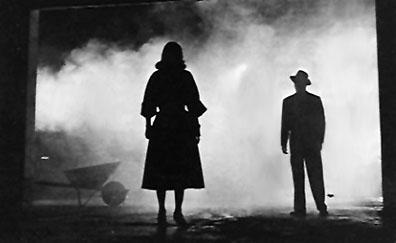Alton's "mystery lighting" imbues Susan's nakedness with the noir concerns of guilt and obsession. She's not a femme fatale, but Lewis and Alton's shot compositions and Wallace's characterization treat Susan as an obsessive female who needs to be contained by the law (Lt. Leonard Diamond) and atone for sexual transgressions. Diamond (Cornell Wilde and Wallace's offscreen husband), too, is obsessed. He has tracked Susan for months and spent his own money in his crazed pursuit to bring down Brown and the combination. He tells the captain, "If I could get a hold of her and make her talk," but the captain reminds Diamond of his real agenda: to reform a "wayward" girl that he loves.
Susan's guilt develops across scenes. Following the elegiac opening, she meets Mr. Audobon, an old family friend, at a posh restaurant. Cryptically, Mr. Audobon comments, "Well you look so different, Susan. Why, I hardly recognized you." Susan says she hasn't changed, but Lewis' cutaway to the two hitmen sitting and eating undercuts her denials. As Susan and Mr. Audobon stroll across the dance floor, Susan, unable to run from herself, collapses: "I've taken some pills. I think I'm dying." Later, at the hospital, Susan's made to feel worse by Diamond who hounds her about Alicia (one of the film's narrative threads). Susan backs away, but Diamond hovers across the bed, "You think you're the bright respectable girl you were four years ago? You're not. You attempted suicide. You're under arrest. You can be sentenced to jail for six months." Diamond's words center around suicide but the real undercurrent of his accusations concern what Susan and Brown do in the dark.
Diamond's obsession slowly reaches Susan. Susan, in white, tries to reclaim lost innocence by listening to a private recital, but Diamond barges in and shocks her reveries. "You think this is mink, Miss Lowell," he asks, grabbing her furs. "These are the skins of human beings, Miss Lowell. People who have been beaten, sold, robbed, doped, murdered by Mr. Brown." She doesn't want to hear the truth, and Lewis and Alton reflect this mood by alienating Wallace from Wilde in a wonderfully staged two-shot. The performers look ahead, through the camera, rarely at each other. Separate but together, she offers her first confession: "I live in a maze, Mr. Diamond. A strange blind and blackened maze and all of the little twisting paths lead back to Mr. Brown." Earlier she had told Brown, "I hate and despise you," but his power of lovemaking captivated her with noir's transgressive promise. Conte had followed her statement with kisses to her cheek, neck and then traveled down, behind her body, as the camera dollied in for a stunning erotic close-up. Diamond follows her confession with one of his own. He tells her to get out, to save herself from Brown, and then admits that he, too, loves her. Susan breaks the mood of alienation. She turns and looks directly at Diamond.
Her first look becomes a committed second look following the brutal death of Rita (Diamond's on-and-off again burlesque-hall girlfriend). Susan visits Diamond at the police precinct with a photograph of Alicia. The thread is followed and they find Alicia, Brown's estranged wife, at a sanatorium. Susan, in front of the police, Diamond and Alicia pleads, "Haven't I humiliated myself enough?" Diamond says no one has done enough, and Susan provides her second confession, admitting before Alicia and a group of men that she was Brown's girl. Alicia acknowledges Susan's guilt and punishes her further, "Then why did you stay four years, why did you start?" Diamond asks Alicia to see the connection between herself and Susan, a younger version of herself. Alicia refuses to help and then Diamond shows her a photograph of Rita's bullet-riddled body. Alicia acquiesces and Susan, glancing at the photograph and guilty by association, crumples in tears, her transgressive sexuality punished.
The film's ending is cathartic: Susan frees herself from guilt and Brown's gaze; Brown, who's responsible for the deaths of Rita, McClure, Dreyer, Fanty and Mingo and lived by the ruthless motto "First is first and second is nobody," is reduced to a nobody. As Brown paces inside the airport hangar and wonders where that "stupid pilot" is, Susan coolly lights a cigarette. Conte knocks the lighter free with a left hand, and then slaps her with his right. "I want to be seen," she says, and Brown threatens, "Don't try that again." Moments later, a police car pulls up, and Brown looks into the dark fog and retreats, sliding into a corrugated tin wall. Susan watches and sizes him up. Diamond's disembodied voice tells Brown to "C'mon out." He starts firing into the darkness and Susan adjusts the car searchlight and shines it on Brown. She seizes control of the mise-en-scene and ascertains somebody else's guilt besides her own. Brown is now totally undercut. Through a series of eyeline matches he can't see anything, only fog, darkness and bright glaring spots of light. He can no longer order the universe. Impotent, he fires at the beam but she keeps it shining. Emblematically, he no longer possesses her.
Framing and lighting render Brown powerless, and Susan, although cleansing her guilt by displacing it to Brown, remains somewhat passive moving from one man to another. She watches Brown empty his gun and Diamond emerge, towering over the "little man." Diamond grabs him--"Let's go hoodlum"--and sends him sliding toward two police officers. Diamond then lingers in the hangar, his back to the camera, poignantly silhouetted, and Susan walks toward him. Backlit they stand together, and as David Raksin's love theme swells, they exit into swirling fog. We are left contemplating a haunting image of sentimental toughness. Maybe there's hope for these two, even in a dark world called film noir.


